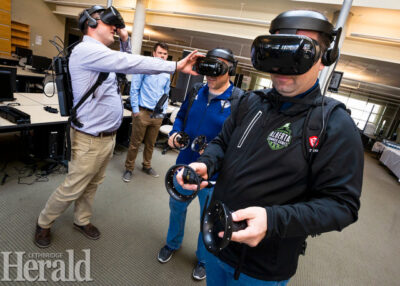Potential for virtual reality continues to expand, SACPA told
By Alejandra Pulido-Guzman - Lethbridge Herald on June 21, 2022.
 Herald file photo
Participants are lead through a virtual reality tour during a Merging Realities conference at Lethbridge College in 2019.
Herald file photo
Participants are lead through a virtual reality tour during a Merging Realities conference at Lethbridge College in 2019.LETHBRIDGE HERALDapulido@lethbridgeherald.com
The Southern Alberta Council on Public Affairs invited Michael McCready to their Thursday presentation to talk about the possibilities and challenges of Virtual and Augmented Reality.
McCready is an educator and researcher with a focus on immersive technologies such as virtual and augmented reality. He introduced one of the first VR development courses at Lethbridge College in 2016 when he taught students to develop mobile VR games.
McCready is also the program research Chair of the Spatial Technologies Applied Research and Training (START) Centre at Lethbridge College. In this role, he works with organizations to integrate immersive technologies to their workflow to improve organizational effectiveness.
“Over the last couple of years and since we’ve been actively focused on this, we brought over $2 million through federal and provincial grants as well as service contracts with community organizations even in Lethbridge here,” said McCready.
He said they are grateful to work with clients and organizations to help them realize the opportunity this technology will provide them.
McCready explained what Virtual Reality is during his presentation.
“Virtual reality is really about transporting you into a virtual environment, a computer-generated virtual environment,” said McCready.
He also explained the term Augmented Reality which is another common term.
“AR is where we’re overlaying virtual content or digital content on the real world,” said McCready.
He said another term that exists but that is less common is Mixed Reality.
“This is kind of blending of the two, virtual and augmented reality, in that you are taking digital content and overlaying it in the physical world, but where that digital content can interact with the physical world and you can interact with that,” said McCready.
He mentioned in his talk that there is a term that can be used to combine all three concepts.
“XR it’s a terminology that kind of takes all these immersive technologies and put them under an umbrella,” said McCready.
He went on to say that the concept of VR is not new, that it has been around since the early ’60s.
“It’s not a new thing, but because of some of the advent of the Oculus and how it’s really made it more consumer friendly, and as the devices such as our smartphones have become more powerful, that’s really allowed the AR concepts to really become more mainstream,” said McCready.
During his presentation McCready mentioned some of the negative effects of XR like motion sickness, eye strain and collisions with nearby objects.
He mentioned that negative effect expands to mental health risks like anxiety, social isolation and false expectations.
“As you spend so much time in this virtual environment, it could create a sense of anxiety in dealing with the physical and the real world around,” said McCready.
He said the social isolation part, while it is a valid point, is becoming less of an issue because with virtual reality there are many social VR applications available where people can talk, interact and communicate with other people, but what that can do is create those false expectations.
McCready later said that another issue that can arise from XR is ownership of digital property.
“As we start anchoring this AR content around the world, who’s going to decide who owns that digital space?” said McCready.
He then talked about an acronym coined by leading VR researcher and head of the Stanford Virtual Human Interaction Lab, Jeremy Bailenson, called DICE, which stands for Dangerous, Impossible, Counterproductive and Expensive.
He used the acronym to explain when people can use VR. He also talked about other uses for VR like experiencing a brand from a marketing perspective.
Another application he talked about is the use of VR for meet-ups, events and press conferences.
McCready said VR can also be used for storytelling.
“It can elevate storytelling to a complete new level, where the participants can be a part of the story which can be a very powerful way to communicate a message,” said McCready.
He then mentioned other areas where VR can be helpful like tourism, journalism and to develop empathy.
McCready concluded his presentation by talking about the concept of the Metaverse before answering questions from those in attendance.
To watch the full presentation go to https://youtu.be/FGaieqOefWE
Follow @APulidoHerald on Twitter
4-3


